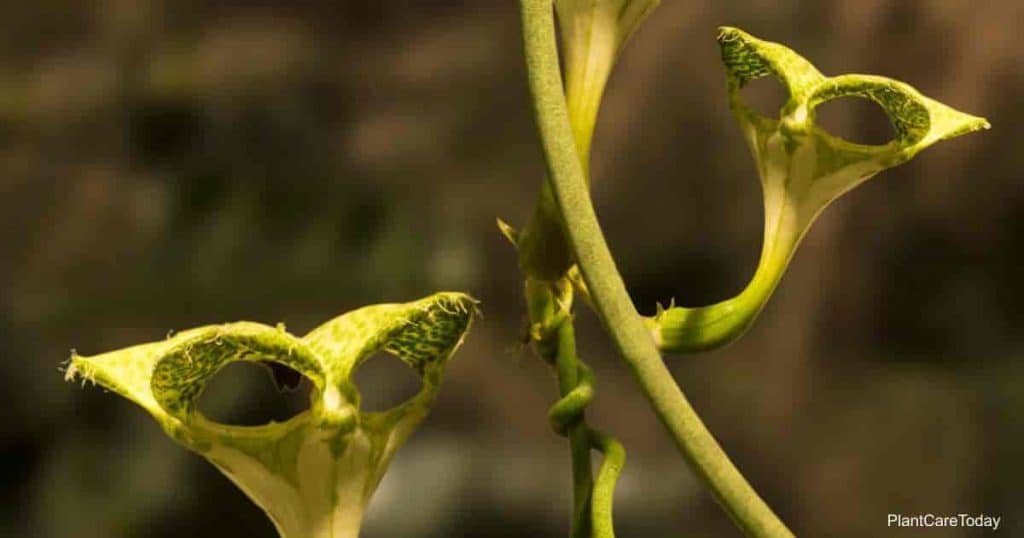Ceropegia sandersonii (seer-oh-PEEJ-ee-uh san-der-SON-ee-eye) is an attractive member of the Apocynaceae family hailing from parts of South Africa, Swaziland, and Mozambique.

It has a wide range of common names, including:
- Fountain flower
- Giant ceropegia
- Parachute flower
- Parachute plant
- Sambreelblom
- Sanderson’s canopy flower
- Sanderson’s Ceropegia
- Trumpet flower
- Umbrella flower
- Umbrella plant
- Windowed flower
Having some of the largest blooms in the Ceropegia genus it is satisfying to grow. Ceropegia woodii is the most popular species.
Parachute Flower Care
Size & Growth
A fast grower has a long lifespan and may grow up to 12’ feet tall with twining vines having proper support.
The roots are white and tend to form in clusters.
This plant has simple, fleshy leaves which grow in pairs and range from an ovate-lanceolate shape to heart-shaped.
Its growing season in the US is from March through August.
Fountain flower blossoms from November to March in the wild. As a houseplant in the northern hemisphere, it flowers from summer to fall and in some areas year-round.
Flowering and Fragrance
The green flowers on the umbrella plant are named for their peculiar shape.
2 to 4 flowers will grow on stalks and contain a corolla measuring 1.6 to 3 5/32” inches tall and 1 to 2” inches across at the top.
The base is swollen and the top extends into five corolla lobes which converge into an umbrella-like canopy containing purple to silky white hairs.
The openings are commonly referred to as windows.
The flowers are either spotted green or a purplish-maroon color while the rest of the flower is pallid green with darker stripes and a cream striped corolla tube.
The plant has a distinct method of pollinating. Sandersonii uses a scent described as being a touch of lime or citrus. It contains substances mimicing the fear pheromones of bees.
The scent attracts carnivorous flies hoping of a meal. The small hairs in the flower trap the flies temporarily where they become coated in pollen during their escape. This turns them into unwilling pollinators.
Light & Temperature
This plant loves indirect, bright light, but direct sunlight should be avoided.
In its natural habitat, the plant is sheltered by surrounding foliage, giving it partial shade.
Full sun can damage the plant in hotter climates.
Ceropegia sandersonii prefers a slightly cooler climate and is best suited for USDA hardiness zones 10b to 11b.
It has some degree of cold resistance, preferring temperatures between 35° and 50° degrees Fahrenheit, but is not frost tolerant.
Watering and Feeding
Water your Parachute plant regularly during the growing season, being careful not to let it dry out.
Give the foliage an occasional spritz with a spray bottle to simulate tropical humidity.
Reduce watering to weekly from late August to January. Don’t water the plant throughout February.
During the growing season, you can provide the plant with a balanced half strength liquid fertilizer once per month.
Avoid using full strength, as the roots are sensitive and may suffer chemical burns.
Soil Type & Transplanting
Overall, this is not a very picky plant when it comes to a potting mix. It does prefer a rich, porous, well-drained mix and does well in a clay pot.
Grooming And Maintenance
The umbrella plant requires about the same amount of care as many succulent plants, with pruning necessary on unhealthy leaves.
As an indoor plant, you may choose to prune from time to time to restrict its growth. This is not necessary when the plant is hanging or allowed to climb.
How To Propagate Fountain Flower
Parachute plant is naturally stimulated to develop roots when its nodes touch soil, making cuttings the easiest way to propagate this plant.
Ensure the cuttings contain a few nodes and let them dry out for a few days. When planting make sure a node comes in contact with the soil.
While less common, it is also possible to grow this plant from seed.
Sow the seeds in well-drained compost and allow between 14 and 28 days for germination, keeping the seed moist and watching out for any moisture-related issues.
Be careful not to overwater a new plant, as the roots will be especially vulnerable to rot.
Both methods of propagation should be carried out in the spring.
Umbrella Plant Pests or Diseases
Succulent mealybugs, red spiders, and wooly aphids are the primary threats to this plant.
Rot is a risk of overwatering. Rot may also be a byproduct of a wooly aphid infestation.
The plant is mildly cold tolerant but cannot handle prolonged exposure to frost or heat.
Suggested Sanderson’s Ceropegia Uses
The stems and leaves of this plant have been consumed as part of traditional native cuisine.
As an ornamental, it grows well in terrariums and in both Mediterranean and tropical themed gardens.
It is commonly used as a container plant, and its vining habits make it perfect for hanging baskets and tight spaces.
Give sandersonii a trellis or other support structure so it can twine its way up the wall.